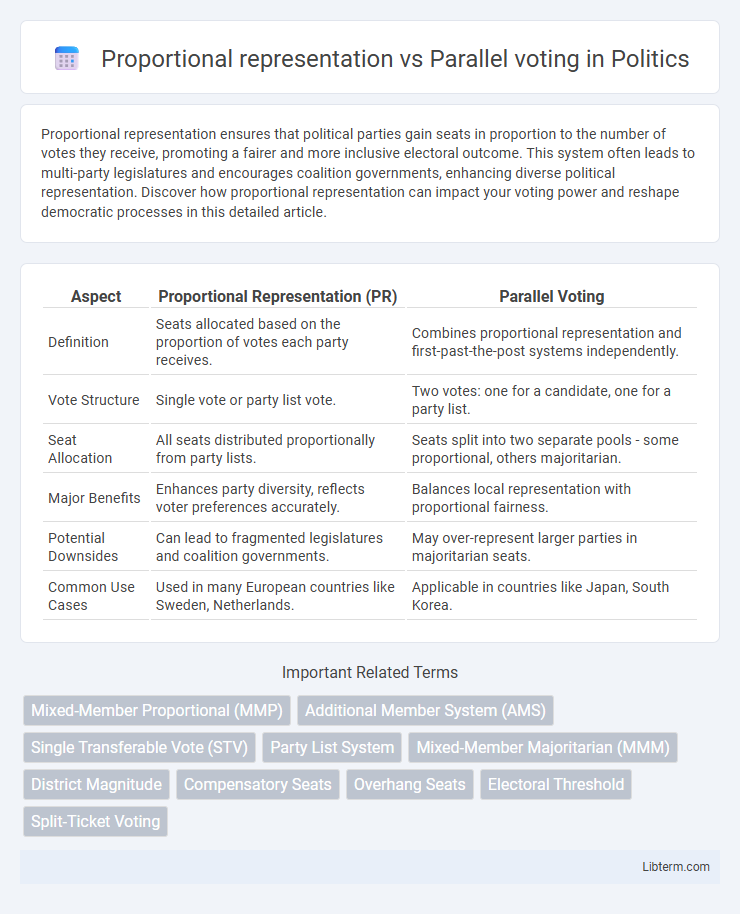Proportional representation ensures that political parties gain seats in proportion to the number of votes they receive, promoting a fairer and more inclusive electoral outcome. This system often leads to multi-party legislatures and encourages coalition governments, enhancing diverse political representation. Discover how proportional representation can impact your voting power and reshape democratic processes in this detailed article.
Table of Comparison
| Aspect | Proportional Representation (PR) | Parallel Voting |
|---|---|---|
| Definition | Seats allocated based on the proportion of votes each party receives. | Combines proportional representation and first-past-the-post systems independently. |
| Vote Structure | Single vote or party list vote. | Two votes: one for a candidate, one for a party list. |
| Seat Allocation | All seats distributed proportionally from party lists. | Seats split into two separate pools - some proportional, others majoritarian. |
| Major Benefits | Enhances party diversity, reflects voter preferences accurately. | Balances local representation with proportional fairness. |
| Potential Downsides | Can lead to fragmented legislatures and coalition governments. | May over-represent larger parties in majoritarian seats. |
| Common Use Cases | Used in many European countries like Sweden, Netherlands. | Applicable in countries like Japan, South Korea. |
Introduction to Electoral Systems
Proportional representation allocates seats based on the percentage of votes each party receives, ensuring minority groups gain fair legislative representation. Parallel voting combines proportional representation and plurality systems but counts them separately, often benefiting larger parties without eliminating disproportionality. Understanding these electoral systems highlights how vote-to-seat translation impacts political diversity and governance stability.
What is Proportional Representation?
Proportional representation is an electoral system designed to allocate seats in a legislature in proportion to the votes each party receives, ensuring minority groups have fair representation. Unlike parallel voting, which combines proportional and majoritarian elements but counts votes separately, pure proportional representation uses party lists or multi-member districts to reflect the overall distribution of voter preferences. This system enhances political diversity and reduces the dominance of major parties by translating vote shares directly into legislative seats.
Defining Parallel Voting
Parallel voting is an electoral system that combines proportional representation and first-past-the-post methods while maintaining separate vote counts for each component. Unlike mixed-member proportional systems, it does not adjust the proportional seats to compensate for disproportionality in single-member districts. This approach allows voters to influence both local candidate selection and overall party representation independently.
Key Differences Between Proportional Representation and Parallel Voting
Proportional representation allocates seats in the legislature based on the percentage of votes each party receives, ensuring a more accurate reflection of voter preferences, while parallel voting combines this proportional system with a separate majoritarian or plurality component. Key differences include the integration of vote counting; proportional representation uses a single formula for seat distribution, whereas parallel voting maintains two independent vote counts and seat allocations that do not affect each other. This results in proportional representation promoting multiparty representation more effectively, whereas parallel voting often supports dominant parties due to its mixed electoral methods.
Advantages of Proportional Representation
Proportional representation ensures a more accurate reflection of voter preferences by allocating seats in the legislature based on the percentage of votes each party receives, enhancing democratic fairness. This system promotes political diversity and minority representation, allowing smaller parties to influence legislation and policy-making. It typically leads to coalition governments that encourage consensus-building and reduce the dominance of major parties, fostering political stability and inclusivity.
Advantages of Parallel Voting
Parallel voting offers the advantage of combining the benefits of both majoritarian and proportional representation systems, allowing voters to have diverse representation while maintaining local constituency accountability. It provides greater electoral fairness by enabling smaller parties to gain seats through the proportional component without losing the direct link between representatives and geographic areas through the majoritarian component. This system enhances political pluralism and stability by balancing broad party support with strong, locally elected officials.
Disadvantages of Proportional Representation
Proportional representation can lead to fragmented legislatures, making it difficult to form stable governments and resulting in frequent coalition negotiations. The system may empower smaller parties with limited public support, causing disproportionate influence in policy decisions. Additionally, it often weakens the direct link between representatives and constituents, reducing accountability.
Disadvantages of Parallel Voting
Parallel voting often leads to disproportional representation since it combines majoritarian and proportional systems without compensating for discrepancies, resulting in overrepresentation of larger parties. Smaller parties struggle to gain seats due to the majoritarian component, limiting political diversity and undermining minority interests. This system can also confuse voters and complicate the electoral process, reducing overall transparency and voter engagement.
Impact on Political Party Systems
Proportional representation (PR) systems tend to encourage multiparty systems by allocating seats based on the percentage of votes each party receives, promoting political diversity and coalition governments. Parallel voting systems combine elements of PR and majoritarian methods, often leading to a mixed-party system where dominant parties benefit from single-member districts while smaller parties gain limited representation through party lists. This hybrid structure can reduce the overall proportionality of election results, often reinforcing the presence of larger parties and weakening smaller or emerging political groups.
Which System is Best for Democratic Representation?
Proportional representation (PR) ensures that political parties receive seats in the legislature closely aligned with their share of the popular vote, promoting diverse and inclusive democratic representation. Parallel voting combines majoritarian and proportional elements but often overrepresents larger parties, potentially undermining minority voices and proportional fairness. Studies indicate that pure PR systems more effectively translate public preferences into legislative seats, making them superior for achieving equitable democratic representation compared to parallel voting systems.
Proportional representation Infographic

 libterm.com
libterm.com